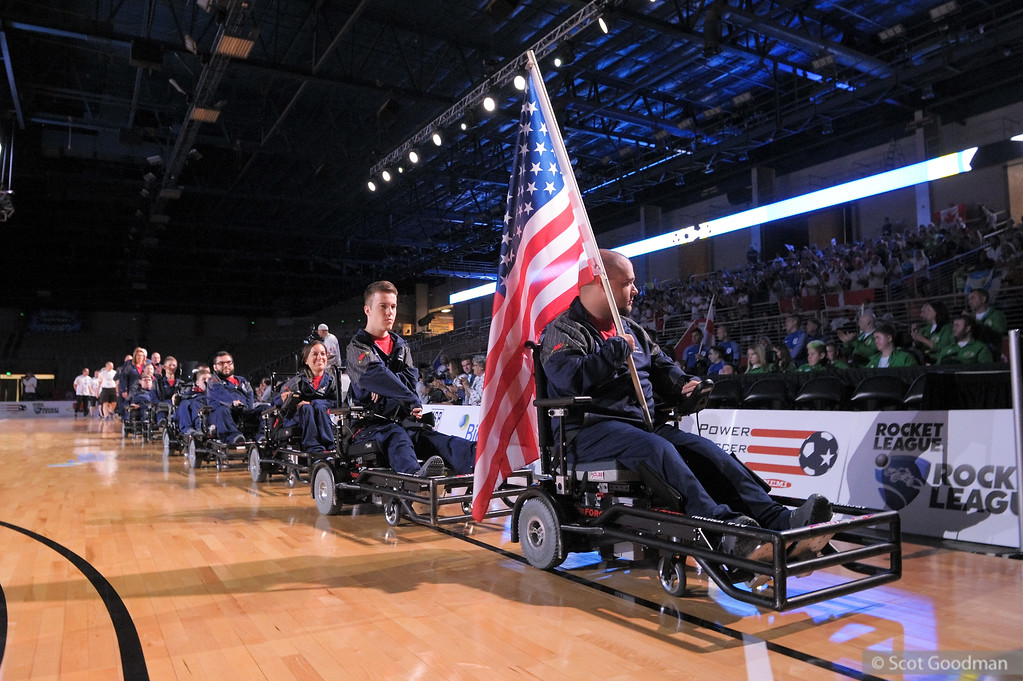Team USA entered the tournament as a favorite looking for its third straight championship. Despite coasting through the group stage and advancing to the final, the USA fell 4-2 to France.
Power Soccer was first introduced in the 70s in France. Over time, the sport spread across the globe with each new country developing variations on how the game was played. This led to a series of international meetings to create unified rules for competition and the formation of the Federation Internationale de Powerchair Football Association (FIFPA) in 2006. That same year, the United States Power Soccer Association (USPSA) was also formed. Two years later, it was accepted as an affiliate member of the United States Soccer Federation. Since its inception, the USPSA has grown to include around 65 competitive teams throughout the country.
Power Soccer is played on a regulation sized basketball court for two 20-minute halves. Utilizing foot guards on their power wheelchairs, two teams of four players push and spin-kick a 13-inch ball into the goal. Teams can be co-ed and players include individuals with quadriplegia, multiple sclerosis, muscular dystrophy, cerebral palsy, head trauma, stroke, spinal cord injury, and other disabilities.
In 2007, the first FIFPA World Cup was held in Tokyo. Team USA was one of the seven countries participating in the event. The US found early success and went undefeated in the first stage. In the semifinals, the US defeated Belgium and set up a final game against France, who had earned a tie in their earlier meeting against the US The rematch proved to be just as close. After three rounds of overtime, the US won in a shootout to become the first-ever World Cup champions.
In 2011, the second World Cup took place in Paris and featured 10 countries. Once again, the US advanced to the final to take on England. In pool play, England had handed the US its only defeat. This time, the US came out victorious, defeating England 3-0. The win gave the US its first ever back-to-back World Cup championships in soccer.

This year, the US had its eyes on extending their streak of championships. Players from all over the country were whittled down to a select 12 who would make up the roster of eight players and four alternates. Three of those individuals were from Minnesota and compete on USPSA teams from the state.
Nathan Mayer plays for MN Shockwave and was goalkeeper for the US. Initially seen as a long shot to make the squad, Mayer put in a lot of training and worked his way to be the first choice keeper. Also representing Minnesota was Riley Johnson who plays for the Minnesota Magic. Johnson has had a lot of success with the Magic, scoring 23 goals in 16 games this season. He turned that into a starting role for the US. Both players made their World Cup debuts this year, but Riley has also represented the US at the U-18 level.
Making the team as an alternate was Pete Winslow. Also from MN Shockwave, this was Winslow’s second time representing the US at the World Cup. Though he did not see playing time, he did act as a commentator for some of the live-streamed games.
The 2017 Power Soccer World Cup took place earlier this month in Kissimmee, Fla. Placed in Group A along with Denmark, Uruguay, Japan, and Argentina, the US went undefeated and only conceded one goal. In the quarter finals, the US defeated Ireland 7-0 to set up a rematch of the last World Cup final against England. In their closest game of the tournament, the US beat England 2-1.
Neither France nor the US had failed to win a game. Both teams had also shown to have high scoring offense and stingy defense during the course of the tournament. Both Mayer and Johnson continued their role as starters for the final.

Unfortunately, it was France that scored first, thanks to an early goal from its captain. It was the first time the US had trailed all tournament, but it would not last long. In the eighth minute, the US was awarded a penalty. Michael Archer saw his attempt saved, but was awarded a redo because the French keeper moved early. Archer buried the second attempt to level the score.
Three minutes later, Archer found Jordan Dickey across court. Dickey spun to send his shot inside the post to give the US the lead. Shortly after, a goal line clearance from Archer was required to keep the advantage for the US.
In the 16th minute, France moved up the floor with a give-and-go pass to open up enough space for a shot and the team’s second goal. The scoreline would remain tied at 2-2 until the second half when a free kick by France found an opening between Mayer and Archer in the 34th minute.
Things went from bad to worse for the US two minutes later when France converted a penalty. With time running out, the US subbed Mayer out for another attacking player. The change did not result in any goals, and the game ended 4-2 in favor of France, ending the US streak of championships at two.
https://twitter.com/FipfaCup2017/status/884782958405722112
FiftyFive.One is now on Patreon. Do you like the independent coverage of soccer news from Minnesota and beyond that FiftyFive.One offers? Please consider becoming a patron.

Leave a Reply